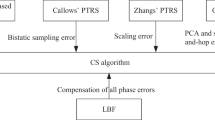Abstract
Among the currently available chirp scaling algorithms for bi-static SAR, some compromise with approximation in the range model, while some others use the equivalent method by first changing bi-static SAR into mono-static SAR then apply chirp scaling algorithm of mono-static SAR. Consequently, as the squint angles get large, the performance of focusing will deteriorate significantly. This paper, however, abandons those traditional solutions to the bi-static imaging problems and introduces a novel method, based on the space model of bi-static platforms. First, a precise range model is established. Then, a new chirp scaling algorithm for bi-static SAR using the precise range model is advanced. It is theoretically proven that this is an analytic solution of the bi-static chirp scaling algorithm. Images can be focused accurately even with large squint angles. At last simulations with large squint angles are made to verify the validity of the algorithm.
Similar content being viewed by others
References
Tang Z Y, Zhang S R. Theory of Bistatic SAR System (in Chinese). Beijing: Science Press, 2003. 43–48
D’Aria D, Rocca F. Bistatic SAR processing using standard monostatic processor. In: Proc EU SAR 2004 Conf, Ulm: Germany, 2004. 567–570
Zhu Z B, Tang Z Y, Jiang X Z. Research on bistatic SAR imaging. In: Geoscience and Remote Sensing Symposium, 2006. IGARSS 2006. IEEE International Conference on Volume, Issue. Denver, USA. 2006. 1224–1227
Cheng H, Tao Z, Teng L, et al. Forward looking bistatic SAR range migration algorithm. In: International Conference on Radar, 2006. CIE’ 06. Shanghai, China. 2006. 127–131
Wang F, Tang Z Y, Sun Y J. The extended chirp scaling algorithm for bistatic SAR imaging. In: International Conference on Radar, 2006. CIE’ 06. Shanghai, China. 2006. 801–804
Zhong H, Liu X Z. A fourth-order imaging algorithm for spaceborne bistatic SAR. In: Geoscience and Remote Sensing Symposium, 2006. IGARSS 2006. IEEE International Conference on Volume, Issue. Denver, USA. 2006. 1196–1199
Natroshvili K, Loffeld O, Nies H. Focusing of general bistatic SAR configuration data with 2D inverse scaled FFT. IEEE Trans Geosci Remote Sensing, 2006, 44: 2718–2727
Natroshvili K, Loffeld O, Nies H. 2D inverse scaling bistatic processing and the focused image quality measurements. In: Geoscience and Remote Sensing Symposium, 2006. IGARSS 2006. IEEE International Conference on Vol-ume, Issue. Denver, USA. 2006. 1188–1191
Zheng Z W, Wang G. The algorithm and system architecture for high resolution real-time spaceborne SAR. In: IEEE International Symposium on Microwave, Antenna, Propagation and EMC Technologies for Wireless Communications, 2005. 1: 415–418
Li N. Research on imaging algorithm for bistatic SAR (in Chinese). Dissertation for Master’s Degree. Changsha: National University of Defense Technology, 2006. 46–51
Author information
Authors and Affiliations
Corresponding author
Additional information
Supported by the National Basic Research Program of China
Rights and permissions
About this article
Cite this article
Li, N., Li, Q., Fan, Y. et al. Chirp scaling algorithm for bi-static SAR using a precise range model. Sci. China Ser. F-Inf. Sci. 52, 1378–1388 (2009). https://doi.org/10.1007/s11432-009-0072-2
Received:
Accepted:
Published:
Issue Date:
DOI: https://doi.org/10.1007/s11432-009-0072-2




